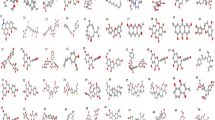Abstract
Use of quantitative structure–activity relationships for prediction of the antibacterial activity of pleuromutilin derivatives was studied. A suitable set of molecular descriptors was calculated and the important descriptors were selected by using the variable selections of stepwise multiple linear regression and genetic algorithm. Principal-components analysis was used to select the training set. The models were validated by use of leave-one-out (LOO) cross-validation, external test set, and the Y-randomization test. Comparison of the results obtained revealed the superiority of the genetic algorithm over the stepwise multiple regression method for feature selection. One genetic algorithm–multiple linear regression (GA–MLR) model with six selected descriptors was obtained. The root mean square errors of the training and test sets for the GA–MLR model were calculated to be 0.423 and 0.523, and the correlation coefficients were 0.839 and 0.807. The statistical parameter of LOO cross validation test correlation coefficients on the GA–MLR model was 0.760. The predictive ability of the model was satisfactory and it can be used for designing similar groups of antibacterial compounds.
Graphical abstract





Similar content being viewed by others
References
Livermore DM (2003) Clin Infect Dis 36:1058
Ohno A (2004) Infect Control 13:1012
Hirokawa Y, Kinoshita H, Tanaka T, Nakamura T, Fujimoto K, Kashimoto S, Kojima T, Kato S (2008) Bioorg Med Chem Let 18:3556
Hirokawa Y, Kinoshita H, Tanaka T, Nakamura T, Fujimoto K, Kashimoto S, Kojima T, Kato S (2008) Bioorg Med Chem Let 19:170
Hirokawa Y, Kinoshita H, Tanaka T, Nakamura T, Fujimoto K, Kashimoto S, Kojima T, Kato S (2009) Bioorg Med Chem Let 19:175
Hill DL (1972) The biochemistry and physiology of tetrahymena, 1st edn. Academic Press, New York, p 230
Tropsha A, Gramatica P, Gombar VK (2003) QSAR Comb Sci 22:69
Habibi-Yangjeh A, Pourbasheer E, Danandeh-Jenagharad M (2008) Bull Korean Chem Soc 29:833
Habibi-Yangjeh A, Pourbasheer E, Danandeh-Jenagharad M (2008) Monatsh Chem 139:1423
Habibi-Yangjeh A, Pourbasheer E, Danandeh-Jenagharad M (2009) Monatsh Chem 140:15
Hansch C, Taylor J, Sammes P (1990) Comprehensive medicinal chemistry: the rational design, mechanistic study and therapeutic application of chemical compounds, vol 6. Pergamon, New York, pp 1–19
Moran PAP (1950) Biometrika 37:17
Geary RC (1954) Incorp Statist 5:115
Hu R, Doucet JP, Delamar M, Zhang R (2009) Eur J Med Chem 44:2158
Deeb O, Hemmateenejad B (2007) Chem Biol Drug Des 70:19
HyperChem Release 7, HyperCube Inc (2002). http://www.hyper.com
Todeschini R, Consonni V (2000) Handbook of molecular descriptors. Wiley-VCH, Weinheim
Todeschini R, Milano Chemometrics and QSPR Group (2002). http://www.disat.unimib.it/chm
Holland H (1975) Adaption in natural and artificial systems. The University of Michigan, Ann Arbor
Cartwright HM (1993) Applications of artificial intelligence in chemistry. Oxford University, Oxford
The Mathworks Inc (2002) Genetic algorithm and direct search toolbox users guide, Massachusetts
Agrawal VK, Khadikar PV (2001) Bioorg Med Chem 9:3035
OECD (2007) Guidance document on the validation of (quantitative) structure–activity relationships [(Q)SAR] models. Organisation for Economic Co-Operation and Development, Paris
Netzeva TI, Worth AP, Aldenberg T, Benigni R, Cronin MTD, Gramatica P, Jaworska JS, Kahn S, Klopman G, Marchant CA, Myatt G, Nikolova-Jeliazkova N, Patlewicz GY, Perkins R, Roberts DW, Schultz TW, Stanton DT, van de Sandt JJM, Tong W, Veith G, Yang C (2005) Altern Lab Anim 33:155
Eriksson L, Jaworska J, Worth AP, Cronin MTD, McDowell RM, Gramatica P (2003) Environ Health Perspect 111:1361
Jaworska JS, Nikolova JN, Aldenberg T (2005) Altern Lab Anim 33:445
Author information
Authors and Affiliations
Corresponding author
Rights and permissions
About this article
Cite this article
Dolatabadi, M., Nekoei, M. & Banaei, A. Prediction of antibacterial activity of pleuromutilin derivatives by genetic algorithm–multiple linear regression (GA–MLR). Monatsh Chem 141, 577–588 (2010). https://doi.org/10.1007/s00706-010-0299-z
Received:
Accepted:
Published:
Issue Date:
DOI: https://doi.org/10.1007/s00706-010-0299-z




